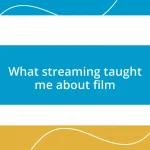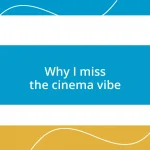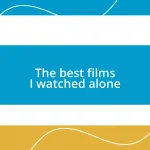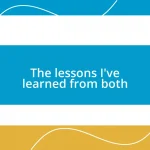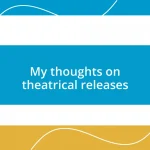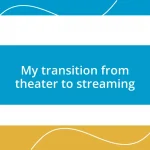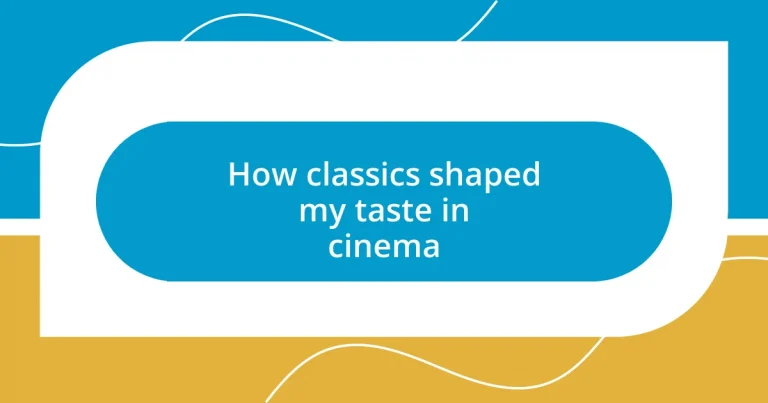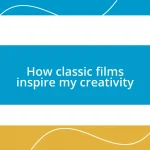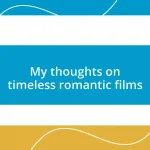Key takeaways:
- Classic films like “Casablanca” and “The Godfather” shape viewers’ expectations by showcasing deep emotional narratives and complex characters.
- Key cinematic elements, such as universal themes and intricate character arcs, enhance modern storytelling and foster deeper emotional connections.
- Reflection on classic cinema influences personal growth, encouraging viewers to confront moral dilemmas and embrace the complexities of life through film.
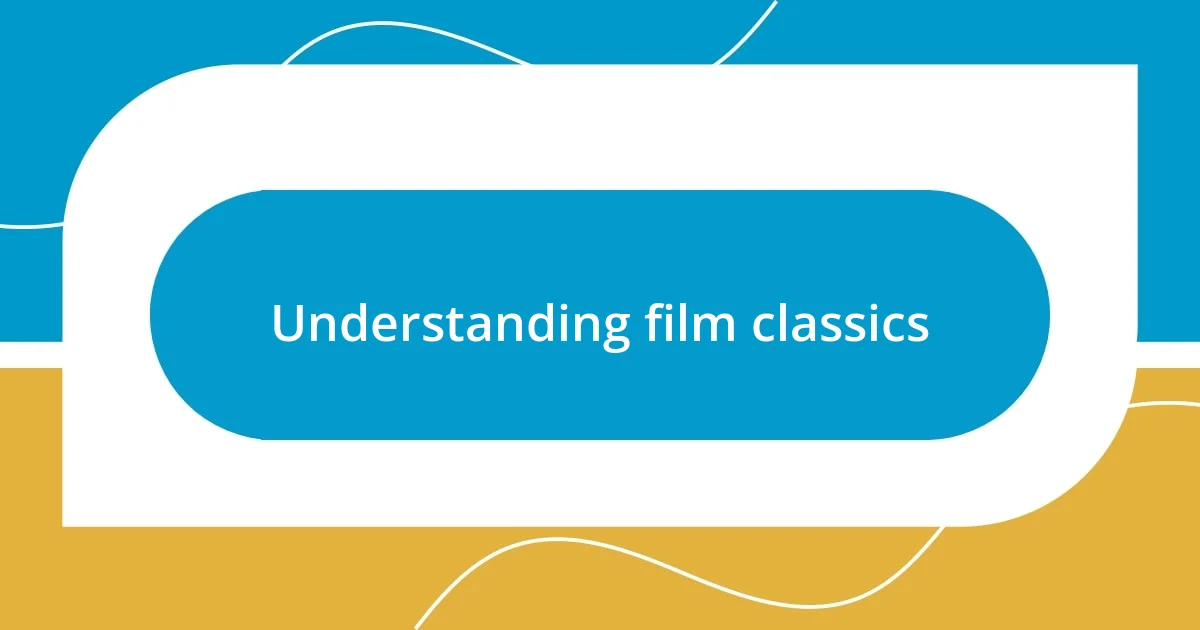
Understanding film classics
Film classics are often more than just old movies; they represent the pillars of storytelling, cinematography, and cultural reflection. I still remember the first time I watched “Casablanca.” As I sat captivated by the performances and the haunting score, I realized that classic films use nuanced dialogue and sweeping visuals to convey deep emotions and timeless themes. Isn’t it fascinating how a black-and-white film can still resonate with us today, lingering in our hearts long after the credits roll?
Delving into classics invites us to explore the very essence of filmmaking. When I reflect on my experience watching “Gone with the Wind,” I find that the sweeping landscapes and passionate characters effortlessly transport us to another era. How do these films encapsulate the ethos of their time while still speaking to us? I believe it’s their ability to grapple with universal human experiences—love, loss, conflict—within the confines of specific historical contexts. This duality enriches our understanding of both cinema and the human condition.
What strikes me most is how these classics can shape our expectations and preferences in film today. After often revisiting “The Godfather,” I’ve developed a keen appreciation for character depth and moral complexities, which I now seek in modern storytelling. Have you noticed how certain films alter your perspective on what makes a narrative compelling? It’s a transformative experience, reminding us that great cinema has the power to shape not just our taste but our very understanding of art itself.
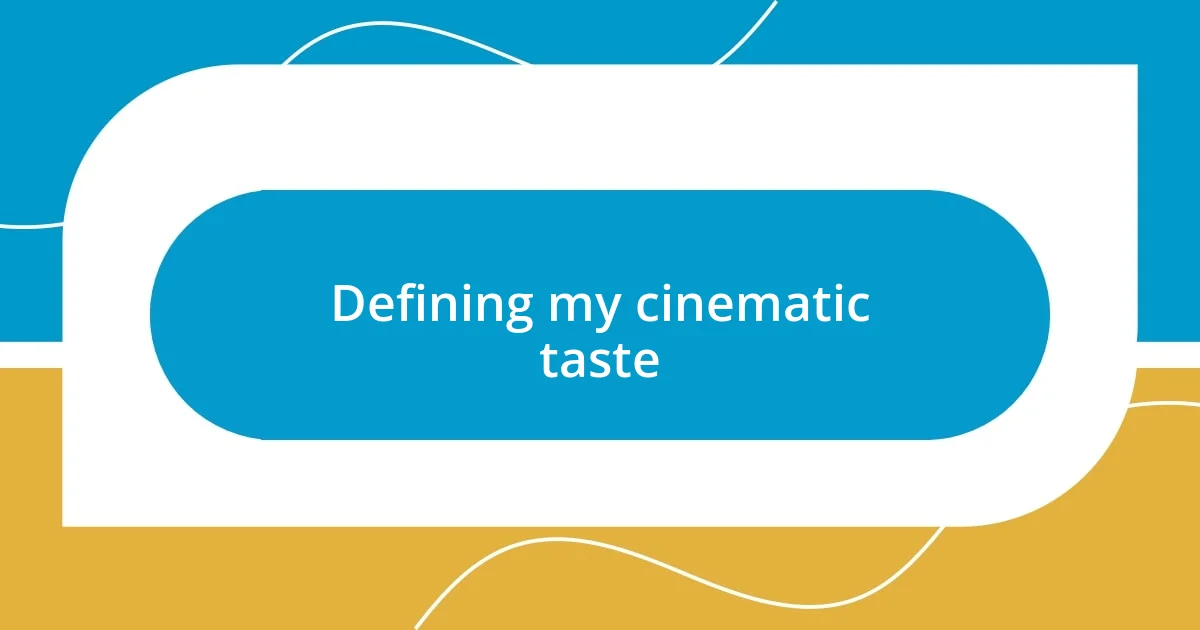
Defining my cinematic taste
There’s something truly special about how the classics have molded my view of film. I remember the first time I experienced “12 Angry Men.” The entire movie takes place in a claustrophobic jury room, yet the gripping dialogue and moral dilemmas unfolded a world of intense human emotions. It taught me that a great story doesn’t require extravagant budgets; instead, it thrives on dialogue and character development. Can you believe how much power a simple conversation can hold?
As I dove deeper into the realm of classic films, certain themes became clear to me. Watching films like “Rear Window” opened my eyes to the art of suspense and voyeurism in storytelling. That moment when I felt my heart race alongside the protagonist as he peered through his camera lens was unforgettable. I found myself analyzing not just what was presented on screen but also how it resonates in our everyday lives. It’s a connection that goes beyond entertainment; it’s about reflecting our own experiences and fears.
These films have not only influenced my preferences but have also ignited a passion for narrative style. I find myself gravitating towards movies that prioritize character-driven stories and intricate plots. For instance, when I watch “The Apartment,” the delicate balance between humor and heartbreak feels so authentic and relatable. Have you experienced that tug-of-war in your heart while watching a film? I cherish those moments since they reveal the true power of cinema to evoke genuine emotions and connections.
| Film | Impact on My Taste |
|---|---|
| “Casablanca” | Taught me the beauty of dialogue and emotional depth. |
| “12 Angry Men” | Highlighted the significance of character and moral complexity. |
| “Rear Window” | Expanded my appreciation for suspenseful storytelling. |
| “The Apartment” | Showed the balance between humor and heartbreak in storytelling. |
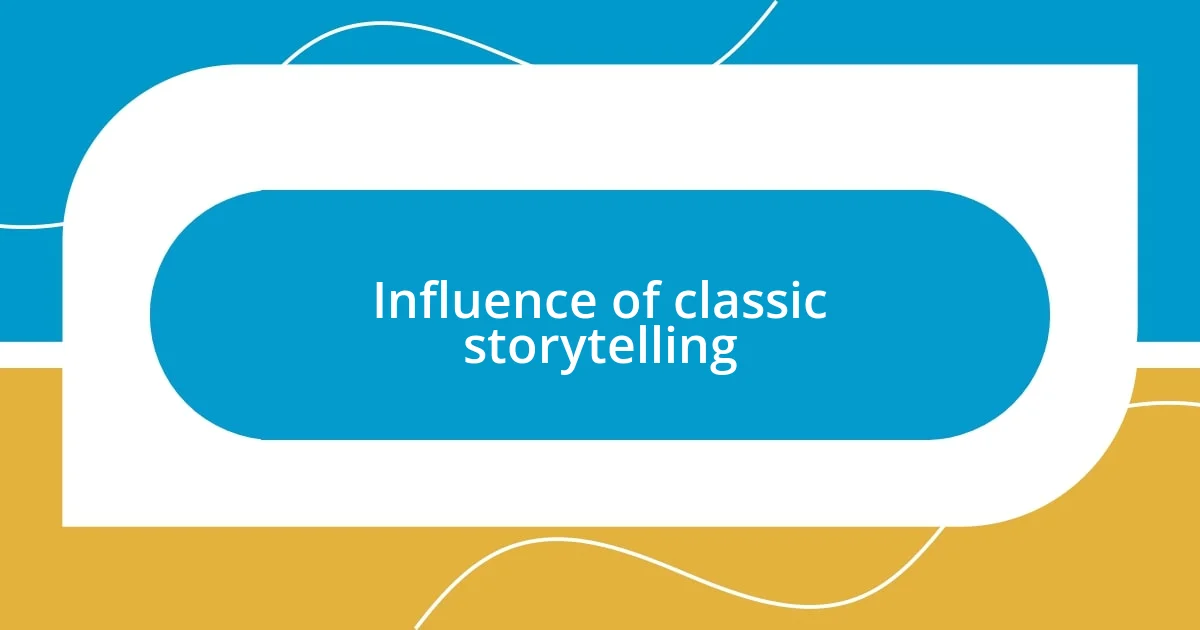
Influence of classic storytelling
Classic storytelling has a profound influence on how I perceive narratives in film. One evening, as I watched “The Wizard of Oz” for what felt like the hundredth time, I was struck by the intricate layers of character development and moral lessons wrapped in a colorful adventure. The journey of Dorothy—a quest to find her way home—resonated deeply with my own sense of belonging and purpose. It’s fascinating how these timeless tales can speak to personal experiences, reminding us of the importance of courage and friendship.
I often find myself reflecting on classic storytelling elements that consistently appear in films. Here are a few core aspects that have shaped my cinematic taste:
- Universal Themes: I appreciate how classics tackle timeless themes like love, sacrifice, and redemption that resonate across generations.
- Character Arcs: The progression of characters, like the transformation of Ebenezer Scrooge in “A Christmas Carol,” teaches me the significance of growth and personal change.
- Narrative Structure: The classic three-act structure often provides a satisfying rhythm and clarity, making stories easier to connect with emotionally.
- Visual Symbolism: I’m continually amazed by how classic films use visual cues—like the yellow brick road in “The Wizard of Oz”—to enhance storytelling and deepen symbolism.
- Cinematic Techniques: Classic filmmaking techniques, like lighting and camera angles, create atmospheres that pull me into the characters’ emotional realities.
Through these insights, I’ve come to recognize that the art of storytelling in classic films is a blueprint guiding my appreciation for modern cinema.
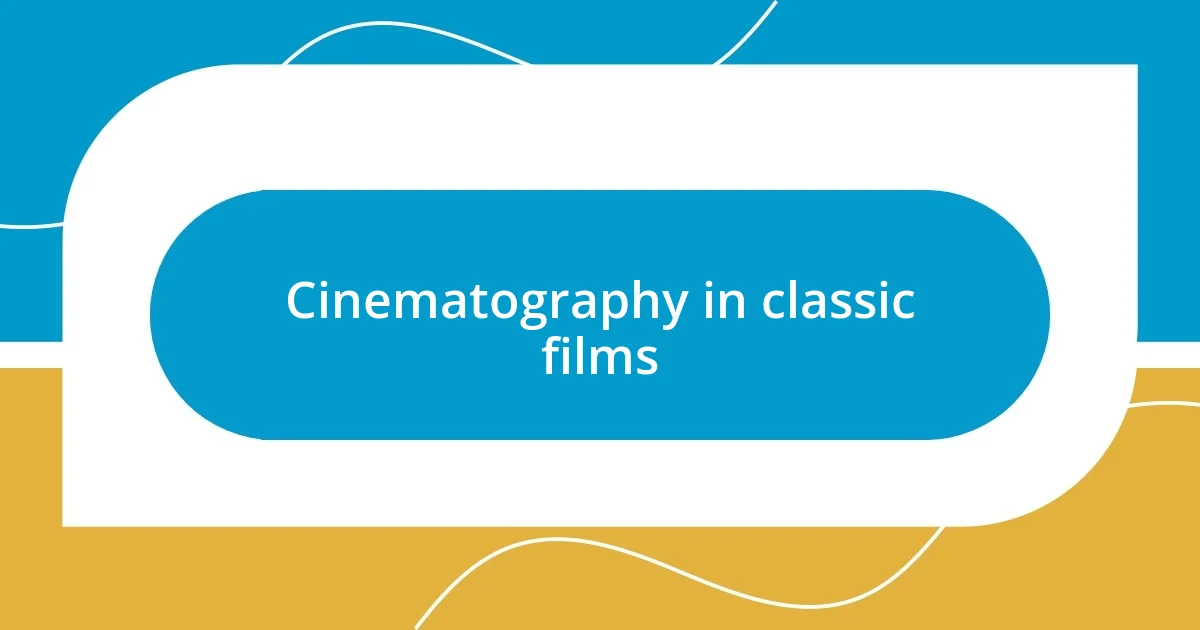
Cinematography in classic films
Cinematography in classic films has an undeniable way of shaping our viewing experience, often elevating the narrative beyond mere dialogue. I vividly recall the first time I watched “Gone with the Wind.” The sweeping landscapes and meticulously framed scenes instantly transported me to another era, illustrating how visuals can evoke emotions just as powerfully as words. Have you ever felt your breath catch during a breathtaking shot? It’s moments like that which made me appreciate the artistry involved in film.
In films like “The Graduate,” the use of composition and light really struck me. The intimate close-ups of Dustin Hoffman’s character reflected his growing isolation, driving home the emotional weight of his journey. This thoughtful use of cinematography taught me that sometimes, less is more; a single image can encapsulate complex feelings. I find myself constantly searching for those visually rich moments in modern cinema—are they as impactful?
Another aspect of classic cinematography that resonates with me is the meticulous attention to detail in each frame. Watching “Citizen Kane” for the first time, I was captivated by how Orson Welles used deep focus to allow multiple actions to unfold simultaneously. It’s a technique that not only demands the viewer’s attention but also enriches the narrative. Reflecting on it, I can’t help but admire how these stylistic choices give birth to layers of meaning—how the camera’s gaze can truly shape our understanding of a story. Isn’t it fascinating how a simple shot can communicate what dialogue may fail to express?
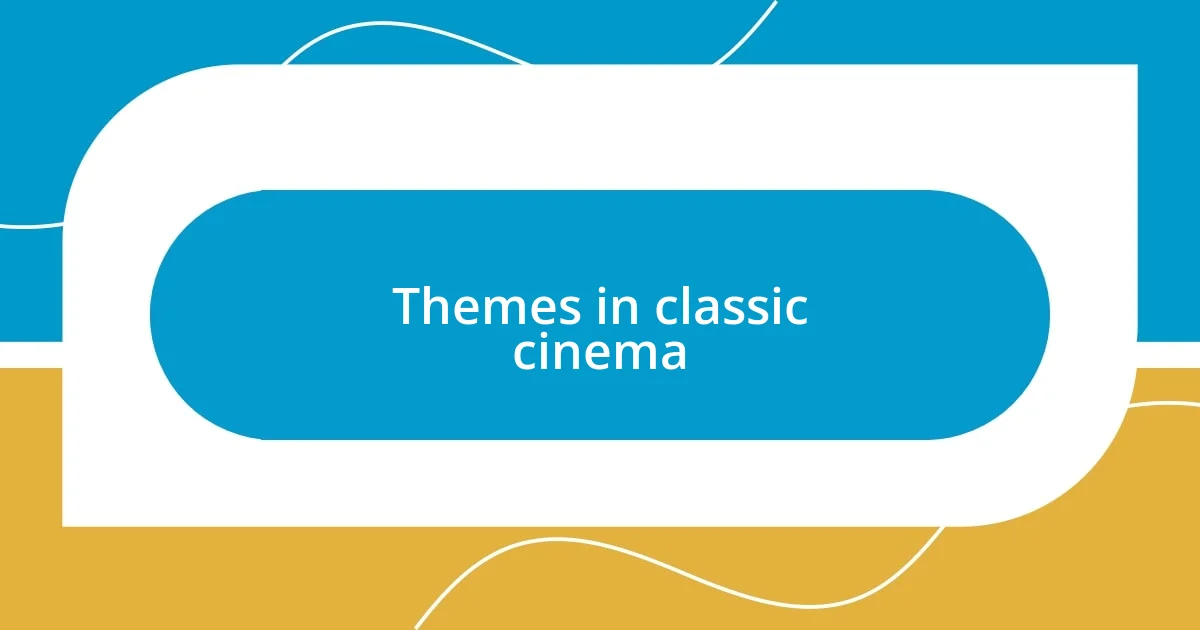
Themes in classic cinema
Classic cinema is rich with themes that resonate on a deeply emotional level. Take, for instance, the concept of the American Dream presented in films like “It’s a Wonderful Life.” Watching George Bailey’s journey made me ponder the meaning of success and personal fulfillment. Isn’t it incredible how a simple film can make you reflect on your own aspirations and the impact you have on others? That’s the magic of classic storytelling; it mirrors real life and challenges us to consider our values.
I’m captivated by how classic films often explore moral dilemmas. In “Casablanca,” characters are forced to choose between love and sacrifice, highlighting a conflict I find so relatable. I remember feeling torn alongside Ilsa when she had to decide her future. It’s moments like those that remind me of the complexities of human emotions and relationships. They prompt reflections on my own choices, forcing me to confront what really matters when faced with tough decisions.
The theme of nostalgia also permeates classic cinema, evoking feelings of yearning and fondness for simpler times. I often think back to “Roman Holiday,” where Audrey Hepburn’s enchanting spirit left me longing for adventure. Her character’s brief escape from reality speaks to a part of me that constantly seeks joy in fleeting moments. All around us, classic films stir a sense of connection—not just to the characters, but to parts of ourselves we cherish. Do you find yourself reminiscing about the past through these cinematic lenses? I believe that’s a distinctive power of classic cinema—it invites us to relive memories and dreams with every viewing.
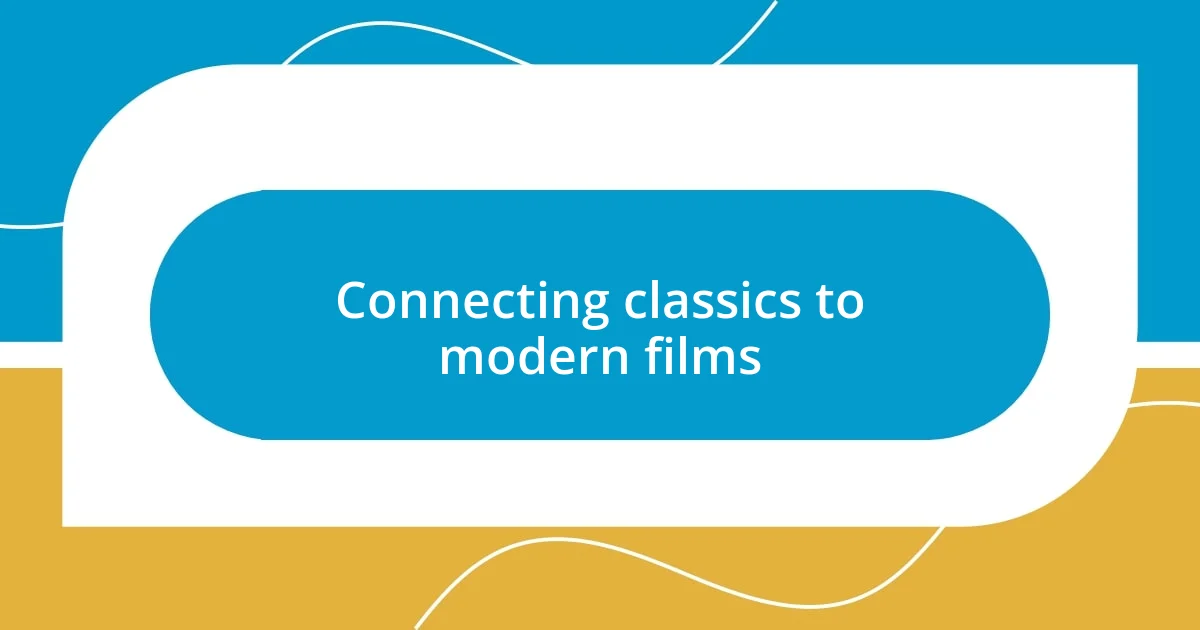
Connecting classics to modern films
When I think about how classic films influence modern storytelling, I often reflect on how vibrant characters shaped my expectations. There’s something about the depth of characters like Scarlett O’Hara in “Gone with the Wind” that makes me yearn for the same complexity in today’s films. Have you ever watched a modern film and wished for a character who felt as real, as flawed, or as beautifully contradictory? I certainly have, which leads me to appreciate when contemporary filmmakers pay homage to their predecessors.
Another striking connection I notice is how certain themes from classic films echo in modern narratives. For instance, the exploration of identity in classic films like “All About Eve” continues to surface in contemporary works. Watching Eve Harrington strive for success made me think about how ambition can sometimes blur the lines of morality. I often find myself drawing parallels to modern films that depict similar struggles. Isn’t it intriguing how these timeless themes evolve yet remain relevant across generations?
Then there are stylistic elements that today’s directors reimagine. For example, take the way Quentin Tarantino spices up his films with homage to classic cinema. I was impressed by how he borrowed from the dialogue-driven pace of films like “The Maltese Falcon.” It made me excited about how old techniques are repurposed in new, innovative ways. Have you noticed how certain shots or settings remind you of a classic you’ve loved? It’s a beautiful way to keep the legacy alive, proving that the past still matters in shaping what we watch today.
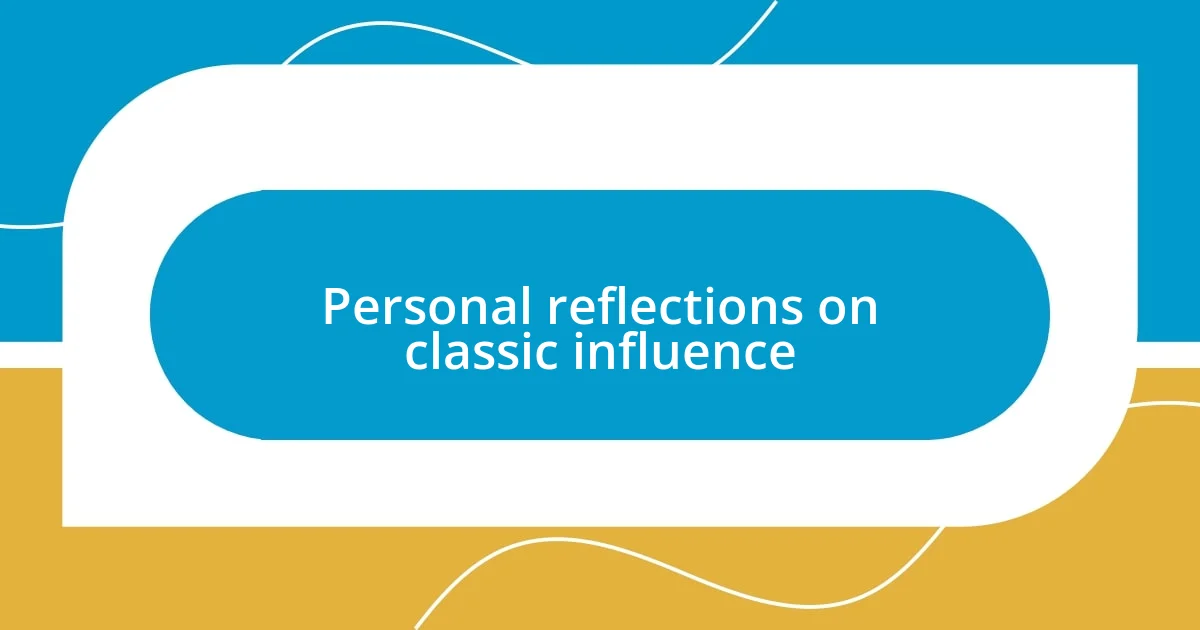
Personal reflections on classic influence
As I reflect on the influence of classic cinema in my life, I can’t help but feel a sense of gratitude for the lessons they imparted. For example, I remember first watching “To Kill a Mockingbird” and being profoundly moved by Atticus Finch’s unwavering moral integrity. It challenged me to think about what it means to stand up for justice and how our choices shape the world around us. Have you had similar moments when a character’s values struck a chord within you?
I often find myself revisiting classic films during moments of uncertainty. There’s a comfort in the familiar plots and characters—like slipping into an old sweater. Watching “The Wizard of Oz,” I was reminded that courage and friendship often lead us on unexpected journeys. It’s funny how these films can evoke a sense of nostalgia while simultaneously encouraging me to embrace the unknown. Can a simple movie offer life lessons? I believe so, as they navigate the complexities of both personal growth and human experiences.
The emotional depth in these classics leaves a lasting imprint on my taste in cinema. When I first experienced the haunting beauty of “Sunset Boulevard,” it awakened my interest in stories that delve into the darker aspects of fame and ambition. I find myself drawn to films that explore such themes, as they resonate with my own fears and aspirations. Are you moved by the darker sides of life in film? For me, it’s these reflections that enrich my viewing experience, fostering a deeper connection to the stories we tell.

